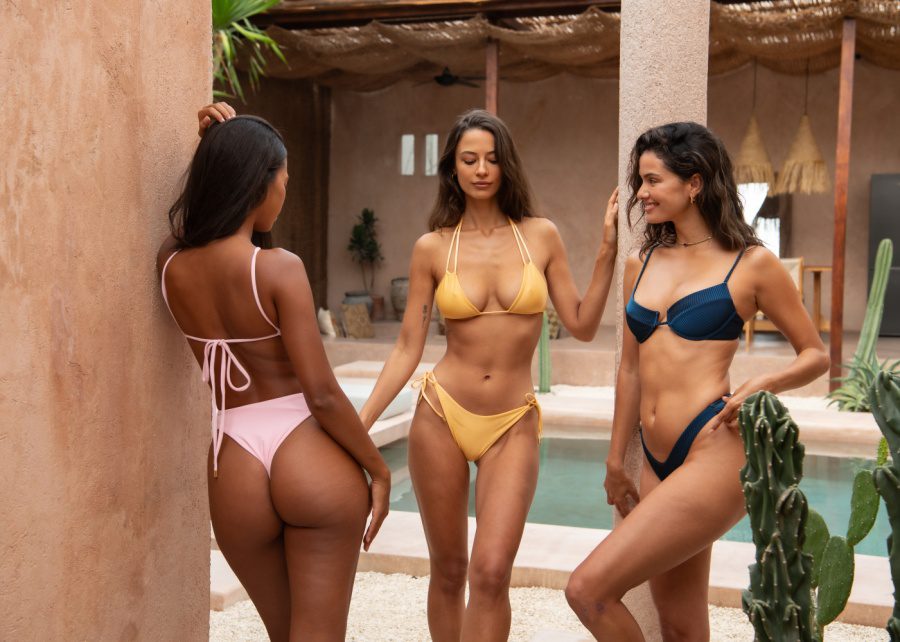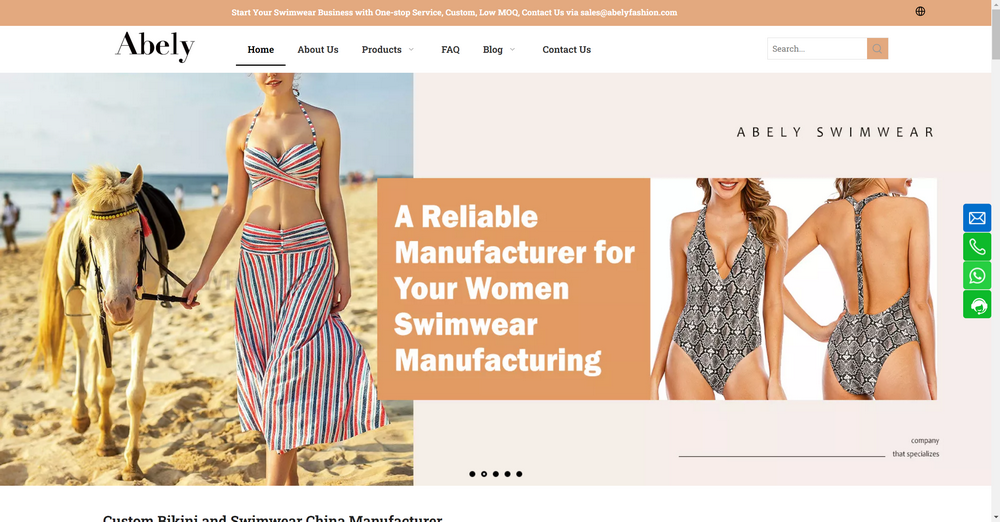Content Menu
● The Rise of Swimwear Manufacturers in Asia
● Why Choose Asian Swimwear Manufacturers?
● Top Swimwear Manufacturers in Asia
● Sustainability in Swimwear Manufacturing
● Understanding Market Trends
● How to Choose the Right Swimwear Manufacturer
● Challenges of Sourcing Swimwear from Asia
● The Future of Swimwear Manufacturing in Asia
>> Key Innovations on the Horizon
● Conclusion
● Frequently Asked Questions
>> 1. What should I consider when choosing a swimwear manufacturer?
>> 2. Are there sustainable options available among Asian swimwear manufacturers?
>> 3. What types of swimwear can I source from Asian manufacturers?
>> 4. How do I ensure product quality when working with a manufacturer?
>> 5. Can I customize my swimwear designs with Asian manufacturers?
● Citations:
The swimwear industry has seen significant growth in recent years, particularly in Asia, where manufacturers are becoming increasingly prominent on the global stage. For brands looking to produce high-quality swimwear, partnering with the right manufacturer is crucial. This article explores the landscape of swimwear manufacturers in Asia, focusing on their capabilities, innovations, and the benefits they offer to brands worldwide.
The Rise of Swimwear Manufacturers in Asia
As consumer demand for stylish and functional swimwear continues to grow, Asia has emerged as a key player in the manufacturing sector. Countries like China, Vietnam, and Indonesia are home to numerous swimwear manufacturers that provide OEM (Original Equipment Manufacturer) services to international brands. These manufacturers not only cater to bulk orders but also offer customization options that allow brands to create unique products tailored to their target markets.

Why Choose Asian Swimwear Manufacturers?
1. Cost-Effectiveness: One of the primary reasons brands choose Asian manufacturers is the cost advantage. Labor costs in countries like China and Vietnam are generally lower than in Western countries, allowing brands to produce high-quality swimwear at competitive prices.
2. Quality Control: Many Asian manufacturers have adopted rigorous quality control processes to ensure that their products meet international standards. This commitment to quality is essential for brands that want to maintain a strong reputation in the market.
3. Innovation and Technology: Asian manufacturers are investing heavily in technology and innovation. From advanced fabric technologies that enhance performance to sustainable manufacturing practices, these companies are at the forefront of industry trends.
4. Diverse Product Range: Swimwear manufacturers in Asia offer a wide array of products, including swimsuits for men, women, and children, as well as accessories like beach cover-ups and bags. This diversity allows brands to source all their swimwear needs from a single supplier.
5. Flexibility and Customization: Many manufacturers provide flexible MOQs (Minimum Order Quantities) and customization options. This flexibility is particularly beneficial for emerging brands or those looking to test new designs without committing to large orders.
Top Swimwear Manufacturers in Asia
Here are some notable swimwear manufacturers based in Asia that have gained recognition for their quality and service:
- Dongguan Abely Fashion Co., Ltd.: Known for its extensive experience in the swimwear industry, this manufacturer offers a range of products from professional swimwear to activewear. With over 350 skilled workers, they produce more than 250,000 suits annually.

- Xiamen Unijoy Swimwear Co., Ltd.: Established in 2009, Unijoy specializes in various swimwear products and has built a solid reputation for timely deliveries and quality control.
- Pokeek Zimo Garment Limited: This manufacturer provides a wide variety of swimwear options and has established relationships with popular brands across Europe, Asia, and America.
- Hongyu Apparel: Recognized for its commitment to quality and trend-forward designs, Hongyu Apparel serves both established brands and startups looking for comprehensive manufacturing solutions.
- Simply Saigon: Located in Vietnam, Simply Saigon specializes in bespoke manufacturing and sourcing for swimwear and activewear, offering flexibility with MOQs and a focus on ethical production practices.
Sustainability in Swimwear Manufacturing
As environmental concerns continue to grow among consumers, many swimwear manufacturers in Asia are adopting sustainable practices. This includes using eco-friendly materials like recycled plastics and organic fabrics. For instance:
- Swimwear Bali is known for its sustainable practices by using fabrics made from salvaged fishing nets and ocean plastic waste, ensuring their products are both stylish and environmentally friendly.
- Simply Saigon emphasizes ethical production by ensuring fair wages and safe working conditions while sourcing eco-friendly materials.
These sustainable initiatives not only appeal to environmentally conscious consumers but also help brands differentiate themselves in a crowded marketplace.
Understanding Market Trends
The global swimwear market is projected to reach approximately $30.97 billion by 2024 due to several factors:
- Rising Popularity of Beach Holidays: As more consumers engage in water-based activities and beach vacations, the demand for stylish swimwear increases significantly.
- Changing Fashion Trends: Swimwear has evolved from being merely functional to a fashion statement. Consumers now seek trendy designs that reflect personal style while providing comfort.
- E-commerce Growth: The rise of online shopping platforms has made swimwear more accessible than ever before. Brands can reach wider audiences through digital marketing strategies that resonate with consumers' preferences.
- Influencer Marketing: Social media influencers play a crucial role in promoting swimwear brands, impacting consumer purchasing decisions through endorsements and lifestyle content.

How to Choose the Right Swimwear Manufacturer
Selecting the right swimwear manufacturer involves several key considerations:
1. Assess Your Needs: Determine your specific requirements regarding design, fabric types, production volume, and budget.
2. Research Potential Manufacturers: Look into various manufacturers' reputations by checking reviews, testimonials, and their portfolio of past work.
3. Request Samples: Before committing to a manufacturer, request samples of their products to assess quality firsthand.
4. Evaluate Communication: Effective communication is vital for a successful partnership. Ensure that the manufacturer is responsive and understands your vision.
5. Consider Location: Proximity can affect shipping times and costs. Consider manufacturers located closer to your target market or distribution centers.
Challenges of Sourcing Swimwear from Asia
While there are numerous advantages to sourcing from Asian manufacturers, challenges do exist:
1. Communication Barriers: Language differences can lead to misunderstandings about design specifications or production timelines.
2. Quality Control Issues: Maintaining consistent quality across large orders can be challenging if proper oversight is not established.
3. Shipping Complexities: Longer shipping times can impact product availability during peak seasons or promotional periods.
4. Regulatory Compliance: Ensuring compliance with international trade regulations can be complex when importing goods from overseas manufacturers.
5. Cultural Differences: Understanding local business practices is essential for building strong relationships with suppliers.

The Future of Swimwear Manufacturing in Asia
As the global demand for swimwear continues to rise, Asian manufacturers are poised for further growth. With advancements in technology and a focus on sustainability, these companies will likely play an even more significant role in shaping the future of the swimwear industry.
Key Innovations on the Horizon
- Smart Fabrics: The integration of technology into textiles is expected to become more prevalent, leading to innovations such as UV protection fabrics or water-repellent materials that enhance performance during water activities.
- Customization Options: As consumers increasingly seek unique products that reflect their personal style, manufacturers will likely expand their offerings of customizable swimwear options.
- Sustainable Practices: The trend toward sustainability will continue influencing manufacturing processes as companies adopt eco-friendly materials and reduce waste throughout production cycles.
Conclusion
Partnering with reliable swimwear manufacturers in Asia can provide brands with numerous advantages ranging from cost savings to access to innovative designs. By choosing the right manufacturer, businesses can ensure they deliver high-quality products that meet consumer demands while also embracing sustainability practices that resonate with today's environmentally conscious shoppers.
Frequently Asked Questions
1. What should I consider when choosing a swimwear manufacturer?
- Consider factors such as quality control processes, minimum order quantities (MOQs), customization options, communication effectiveness, and sustainability practices.
2. Are there sustainable options available among Asian swimwear manufacturers?
- Yes! Many manufacturers are adopting sustainable practices by using eco-friendly materials like recycled plastics and organic fabrics.
3. What types of swimwear can I source from Asian manufacturers?
- You can source a wide range of swimwear including swimsuits for men, women, children, bikinis, beach cover-ups, and accessories.
4. How do I ensure product quality when working with a manufacturer?
- Request samples before placing large orders and establish clear quality control standards that align with your brand's expectations.
5. Can I customize my swimwear designs with Asian manufacturers?
- Yes! Most Asian manufacturers offer customization options that allow you to create unique designs tailored to your brand's identity.
Citations:
[1] https://www.swimwearmanufacturers.co.uk/post/global-forecast-for-the-swimwear-market-2024
[2] https://www.hongyuapparel.com/swimwear-manufacturers-china/
[3] https://swimwearbali.com
[4] https://www.swimsuitcustom.com/blogArticle/3
[5] https://markwideresearch.com/asia-pacific-swimwear-market/
[6] https://delhiswimwearfactory.com
[7] http://simplysaigon.com
[8] https://www.abelyfashion.com/the-thriving-bikini-manufacturing-industry-in-thailand.html




















